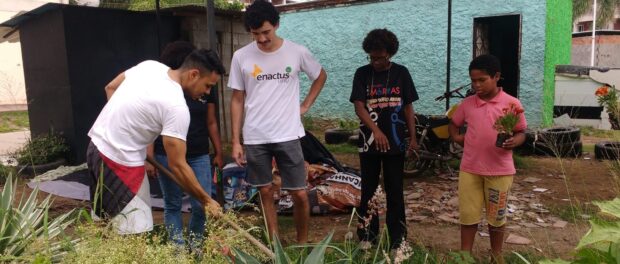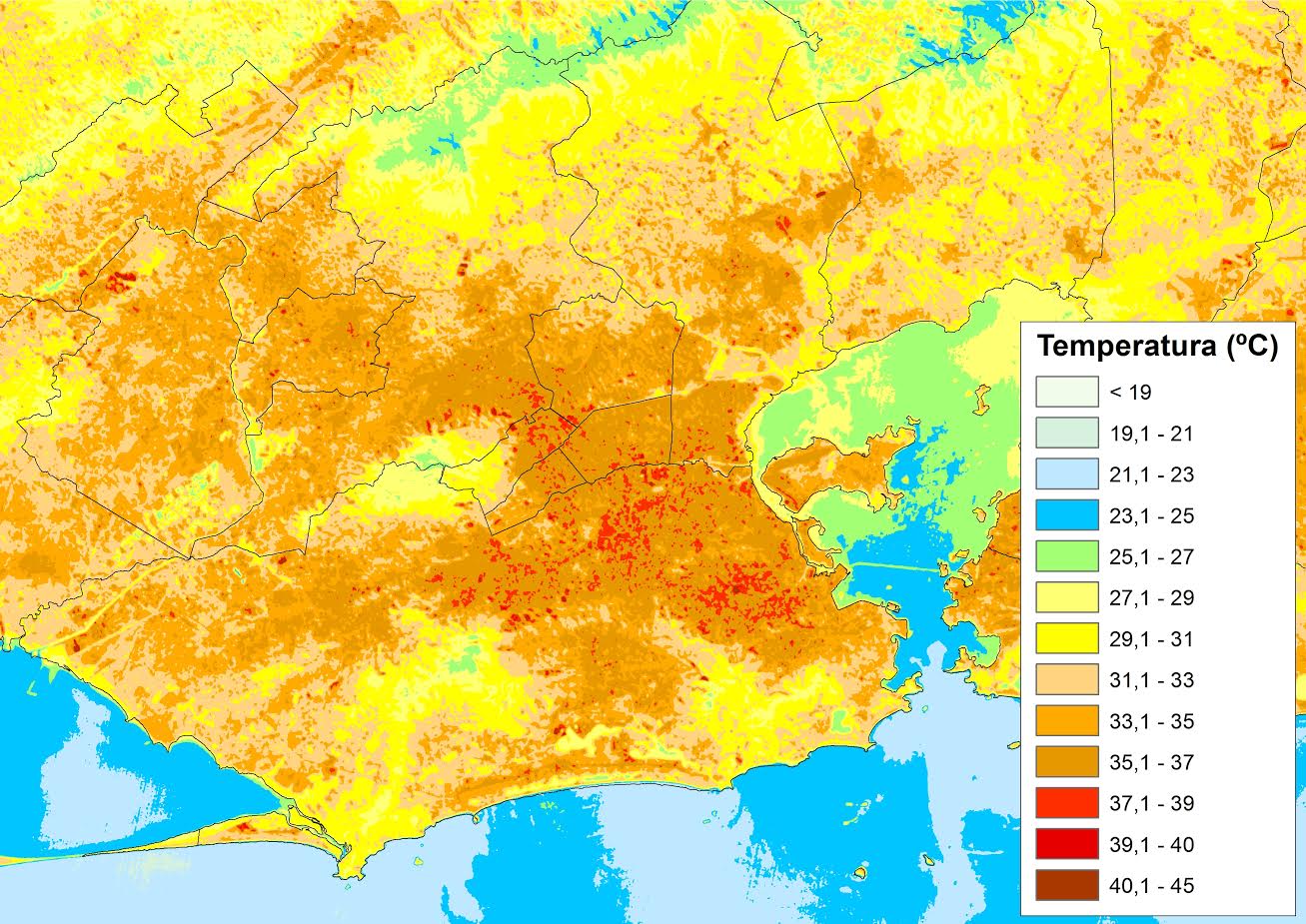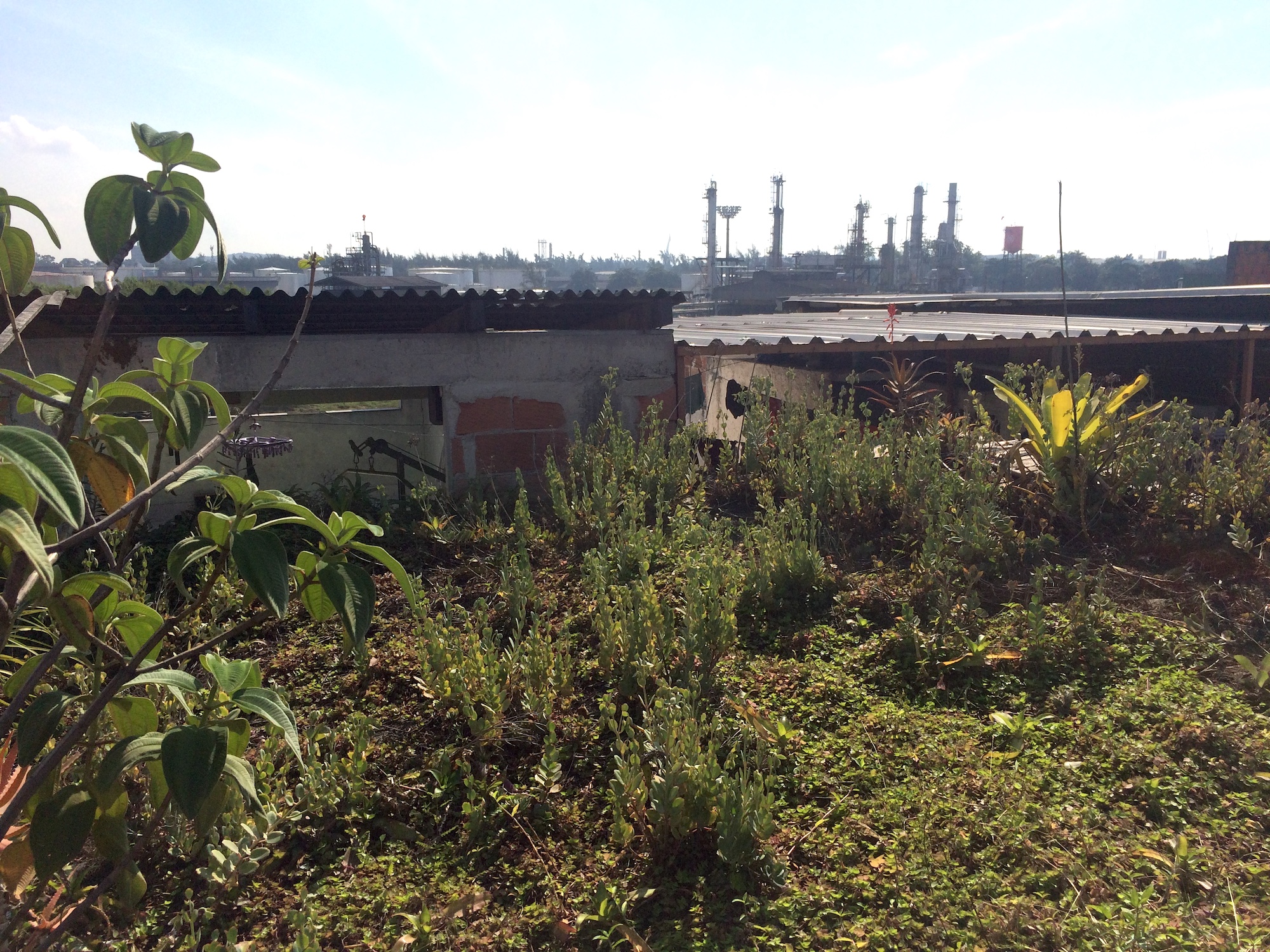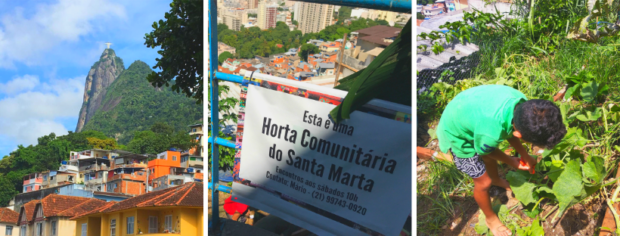
This is our latest article in a series created in partnership with the Behner Stiefel Center for Brazilian Studies at San Diego State University, to produce articles for the Digital Brazil Project on climate impacts and affirmative action in the favelas for RioOnWatch. It is also part of a series created in partnership with the Center for Critical Studies in Language, Education, and Society (NECLES), at the Fluminense Federal University (UFF), to produce articles to be used as teaching materials in Niterói public schools.
The disorganized process of urban occupation and the influence of anthropogenic processes over the past 200 years in Brazil have resulted in many environmental and climate-related challenges which have, in turn, altered the city of Rio de Janeiro. When we think about urbanization, certain images come to mind: cars, pollution, buildings, noise. Urbanization in Brazil took pace at an accelerated pace during the twentieth century. Urbanization in Brazil superseded the US in 1994. Since 1998, 80% of Brazilians have lived in cities and in 2011 the percentage hit 85%. Over the past 70 years the population grew from 70.2 million to 209.3 million inhabitants. This dramatic rise in population and its concentration in large urban centers have created a need for adequate urban planning, which has historically not accompanied this growth.
In 2017, it was estimated that Rio’s metropolitan region was growing by approximately 32 km² per year. The city’s disorderly growth, in a vast area chronically lacking infrastructure and public services, demonstrates an absence of efficient urban policy. We have insufficient schools, hospitals, health clinics, transportation, basic sanitation—and, routinely, piped water, electricity, and garbage collection. Public policies are not efficient in these regions and need to change.
Green spaces have become be increasingly rare and concentrated in neighborhoods with high purchasing power. Rio de Janeiro’s urban tree planting program, for example, varies widely by region. The existing economic divide is visible and blatant. Rio’s affluent South Zone has a large number of trees, parks, and landscaped squares, which create urban cool islands. Meanwhile, the North Zone, with its low purchasing power, is victimized by precarious public infrastructure and a lack of trees. This tree deficit generates urban heat islands. This problem is more than an issue of leisure: the presence of trees is increasingly vital to our health and quality of life.

Thermal Discomfort and Conventional Solutions
Atmospheric changes caused by human action may take place on a large or small scale—and may be irreversible. Urban heat islands, air pollution, variation in rainfall, intense heat, thermal inversion, shifting air currents, and humidity are all phenomena impacted by climate change and which will increasingly challenge life.
Rio de Janeiro is located in an area exposed to extreme weather events. Officially, construction guidelines require high-rises and homes be equipped with passive cooling to achieve greater thermal well-being. Crossing climate data with data on human thermal comfort, official and economically viable strategies for building with passive cooling should be developed in order to achieve thermal comfort and quality of life for all residents in a sustainable manner.
Rio’s many hills and the conditions of many favelas intensify the feeling of discomfort in extreme temperatures. Almost all areas in the city are impermeable and built with materials that absorb heat rather than reflect it, such as asphalt. Favelas are no exception to this model. Land is generally occupied in the favelas by self-built homes due to a lack of housing policy and high prices in the formal real estate market. This creates many densely populated areas which naturally generate a deficit of trees. In addition, the materials used in Rio’s construction culture are not suitable for the city’s microclimatic conditions. They store thermal energy rather than repel it, which transforms many urban areas and favelas into heat islands.
Rio de Janeiro is a city of contrasts, in which areas with socioeconomic conditions, benefits, and costs originating in very distinct environments are found side by side. Thermal discomfort is latent throughout the city, even if neighborhoods are located close to areas with vast vegetation. In this context, it is common to resort to high energy consumption, with technological solutions such as fans, air conditioning, and humidifiers. While these conventional solutions provide respite in the short term and promote temporary thermal well-being, their excessive use leads to energy inefficiency and only intensifies climate change.
This relationship is made evident, for instance, in a technical note published by the state-owned Energy Research Company, which estimates that “energy consumption caused by air conditioners in the residential sector increased by about 237% in the last 12 years, reaching 18.7 TWh in 2017.” Consuming more energy means more deforestation and increased carbon emissions, either from hydroelectric turbines in water-fed areas, or greenhouse gas emissions from the burning of fossil fuels in thermoelectric plants. In addition, ironically, electricity consumption as a cooling strategy requires the expansion and greater maintenance of the existing network, which is a constant reason for the pruning and removal of trees—another contributing factor to increased temperatures.

Several conditions in the urban landscape are replicated in working-class neighborhoods making them hotter: this includes a lack of urban planning, high population density, sparse green infrastructure, poorly ventilated homes, pollution, and improper waste disposal. The unequal occupation of urban land, alongside Rio’s climate and rugged topography, present several different risks, including landslides, floods, and extreme exposure to solar radiation, among others. In this sense, effective public policies are urgent. Complex urban problems demand intelligent and assertive solutions for social transformation.
The Global Scale and Green Infrastructure Against Heat Islands
In recent years, heat indexes in tropical cities like Rio de Janeiro have been reaching new records thanks to climate change. On January 18, 2022, the Riocentro monitoring station recorded an apparent air temperature of 50.8°C in the neighborhood of Barra da Tijuca—the year’s highest and one of the highest temperatures ever documented in the city. The highest ever was in Guaratiba in 2014, which reached 55°C. To fight the heat, many resort to air conditioning, a solution that pollutes the environment, in Brazilian systems still releasing chlorofluorocarbon gas (CFC). Even when used within energy consumption specifications, air conditioning remains harmful to nature and contributes to climate change. Chlorofluorocarbon is one of the main greenhouse gases and is responsible for the destruction of the ozone layer, which protects Earth from the sun’s ultraviolet rays.
With increased energy usage during dry summer months, it is periodically necessary to “raise the red flag”—as Brazil’s highest-priced tax band is known—on electric bills. The “red flag” signals a worsening in power generation conditions. When these occur, thermoelectric plants are activated, preventing electricity shortages by generating energy through burning coal. However, thermal power plants generate polluting gases as by-products: these include carbon monoxide and dioxide (CO and CO2), sulfur monoxide and dioxide (SO and SO2), and nitric oxide (NO). We, therefore, use easier methods to relieve our temperature discomfort, without realizing that we are making the problem worse.
Environmental preservation has gained an increased presence in debates around the world. Major events, such as COP26 in 2021, have discussed environmental impacts generated by human behavior. In this context, so-called “green technologies” have gained popularity in debates. Solutions based on nature and on green infrastructure have been increasingly researched and funded: they appear to be the only way to prevent environmental collapse.
British natural historian David Attenborough, who has devoted his life to the study of life on Earth, offers his vision of a possible future for humanity if the necessary measures to fight global warming are taken immediately. In the documentary David Attenborough: A Life on Our Planet, he reveals striking statistics: the world has lost about 3 trillion trees in the last two centuries and about 15 billion are cut each year. When Attenborough was born in 1926, the world’s population comprised about 2 billion inhabitants. Since then, in less than 100 years, the world’s population has quadrupled to 8 billion people. In addition, Attenborough connects the increased presence of carbon dioxide (CO2) in the atmosphere with consumerism and the destruction of natural habitats. Our own actions are threatening the continuity of civilization.
The climate has already shown irrefutable signs of change, but it is still possible to control this situation for future generations. “A Life on Our planet” presents solutions such as the Netherlands’ sustainable agriculture system, which transformed the country into one of the world’s leaders in food exports. Nature-based solutions (NbS) seek to build resilient cities in the face of climate change. Thus, green infrastructure is an environmental solution, aiming to incorporate greenery which has been expelled from urban environments, to mitigate urban heat islands and increase quality of life, thermal, and visual comfort.
This green reintroduction is happening more and more around the world. One example is the city of Medellín, in Colombia, where green corridors have been built in several strategic areas to lower temperatures. Green roofs, green walls, vertical gardens, and community gardens are being increasingly disseminated among the population. Awareness of the need to use these technologies is necessary and urgent.
Joint actions between countries and agreements to reduce greenhouse gases are important to combat climate change. Facing this crisis, however, must take place between different disciplines and throughout society, taking into account that marginalized populations are the most affected by climate change. We must think globally, but above all, act locally. We must support community actions that promote the expansion of green areas in large city centers and dense urban neighborhoods with insufficient green protection, where urban heat islands are typically common.
The Life at 50°C series, for example, portrays how cities around the world are dealing with rising temperatures as a result of climate change. India has seen an increase in ice sales and in social projects that promote the painting of roofs white. This cools homes through the reflection of light. Aiming to lower temperatures, one man in Karachi, Pakistan has acted to reforest the city, where many suffer from a lack of water infrastructure in temperatures of up to 50°C. Actions like these are noticed and replicated around the world.
Enactus-UFRJ Projects
In Brazil, as well, there is a glaring need to strengthen sustainable cooling projects. Local green solutions and community mobilization are the answer to the scorching temperatures experienced by Rio’s favelas.
In response to this demand, in 2012, Production Engineering students from the Federal University of Rio de Janeiro (UFRJ) created ENACTUS-UFRJ. Today, it operates with over 40 members, working on sustainability projects in four favelas: Caju, Vila Residencial, Santa Marta, and Parque Arará. Here, we will highlight two initiatives that mitigate the effects of climate change in Rio’s favelas: Green Roof Favela and Harvesting the Future.
Green Roof Favela
The initiative was created by resident Luiz Cassiano, also known as Sanduba or Careca, from Parque Arará in Benfica, in Rio de Janeiro’s post-industrial North Zone. Green Roof Favela seeks to increase the presence of green space in the favela by planting and building green roofs in areas that suffer the most from high temperatures. Cassiano not only leads joint actions for green roof construction but also works with audiovisual and cultural media, organizing events and producing training videos that publicize his local green roofing technique.
Their latest project installed a green roof at the local bus stop, which became a haven for birds and pollinating animals, closing the gap between nature and the urban environment. In addition to fighting urban heat islands, the benefits of green roofs range from reducing air pollution to rainwater capture, which helps to minimize flooding.

Harvesting the Future
The Harvesting the Future project revitalizes old waste dump sites in the Santa Marta favela, in Botafogo, turning these places into urban community gardens. By creating new green areas, the initiative also lowers temperatures. In addition, the project develops environmental education alongside local daycare centers. Thus, the initiative spreads a new environmental awareness and food culture among Santa Marta residents.
 Brothers Mario and Marco Martins first began spreading environmental awareness in the community through events, activities at the local daycare center, and the like. Now, project members are working on a 500 m² plot of land that will be able to generate quality organic food for a large share of the area’s inhabitants. The plot will also directly lower local temperatures, mitigating the urban heat island formed in the community.
Brothers Mario and Marco Martins first began spreading environmental awareness in the community through events, activities at the local daycare center, and the like. Now, project members are working on a 500 m² plot of land that will be able to generate quality organic food for a large share of the area’s inhabitants. The plot will also directly lower local temperatures, mitigating the urban heat island formed in the community.
Fighting climate change and environmental injustices, the population of Rio de Janeiro’s favelas is building a more sustainable world. They are mobilizing people and ideas in the struggle for quality of life in their own neighborhoods. After all, the right to the city and the right to the favela also involve climate and environmental justice.
ENACTUS-UFRJ was created in 2012 by Production Engineering students from the Federal University of Rio de Janeiro (UFRJ). Today, it has over 40 collaborators from several undergraduate courses, in addition to professors and partners. It focuses on sustainability-based projects in four favelas: Caju, Vila Residencial, Santa Marta, and Arará.
About the authors:
Ananda Almeida Stroke is an undergraduate student in Environmental Engineering at UFRJ and the leader of the green roof project at ENACTUS.
Amanda Mesquita is an undergraduate student in Literature at UFRJ and a member of the green roof team.
Isabela Mattos e Assumpção is an undergraduate student in Architecture and Urban Planning at UFRJ in addition to being the current president of ENACTUS-UFRJ.
Luana Tresoldi Sciotta is is an undergraduate student in Civil Engineering at UFRJ and a member of the green roof project.

